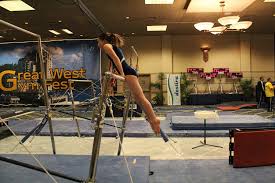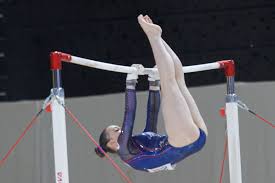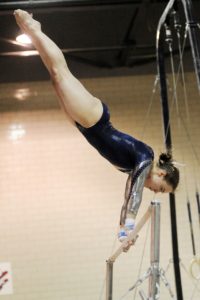This article has been updated to reflect the changes in the 2022-26 Xcel Code of Points, and updated again July 20. 2023.
Xcel gymnastics. These levels used to strike fear into the hearts of judges, when they were first being developed. The rules were so different from J.O. that some judges said they wouldn’t even judge them! We’ve come a long way since then.
The rules make a lot more sense now, and it’s much easier to provide the gymnasts with consistent scoring. I’ll tell you a quick story about Xcel bars from a number of years ago, before many of the current clarifications were in place.
Once, several years ago, I was judging Xcel Gold bars. An entire team from a different state performed a routine beginning with a kip, cast, back hip circle, squat on. At the time, there were no rules listed in the Xcel book that differentiated the extra swings from J.O. rules. So my judging panel deducted for an extra swing. Twice, actually, because the gymnasts performed a similar sequence on the high bar. The coaches were livid. Unfortunately, I had nothing in the rule book to tell us not to take the extra swing deduction. The following year, that rule changed and the extra swings were clarified. If only we had had that clarification a few months earlier!
Xcel bars is an event that can still be difficult to understand, at times. And even if the rules make sense, it can be tough to see all of the errors because bars just moves so fast! No worries. I’ve compiled all the important information about Xcel bars into two articles. This is the first article, featuring the Bronze, Silver, and Gold divisions.

Xcel Bars: Bronze Division
The Bronze Division is the first competitive division in the Xcel program. Bronze level athletes can perform any “A” skills from the Xcel Code of Points, or from the Xcel Bronze chart. New in 2022-2026, Bronze gymnasts are required to perform 4 “A” valued skills on each event. Please note, there are four Special Requirements that must be included in the routine. If a Bronze gymnast has extra swings in her routine, no deduction will be taken for the extra swings. Also, there are no deductions for the amplitude of the casts in any Xcel division.
Value Parts
An Xcel Bronze bar routine must include at least 4 A skills. All skills in gymnastics are evaluated based on their difficulty level, and they are given a value from A through E. A skills are the easiest, while E skills are the most difficult. The gymnast can choose the skills that she can perform the best within the allowable skills for her division.
Each A skill is worth 0.10. Missing A’s are deducted from the Start Value, or the highest possible score of the routine.
Special Requirements
There are four Special Requirements on each event. Special Requirements are certain skills, or categories of skills, that are required.
Each Special Requirement is worth 0.50. The deduction comes off the Start Value if the Special Requirement is missing.
The Bronze Special Requirements are as follows:
- Mount
- Cast (not mount or dismount) in which hips leave the bar
- 360° circling skill (not mount or dismount)
- Dismount from the low bar (no saltos)
Difficulty Restrictions
Next, each Xcel Division has difficulty restrictions. If a gymnast performs a restricted skill, it is a 0.50 deduction from the Start Value, each time.
Here are the Bronze Difficulty Restrictions:
- No B or harder skills
- No skills on high bar
- No salto dismounts
- No giants on low bar
Considerations for Bronze Bars
Bronze bar routines should be quick. The routine only requires four skills, so do the four skills you need to do, making sure that two of them are a cast and a circling skill, then get off the bar. Since the routines are so quick, it’s hard to get a lot of deductions. However, I have really seen them add up when skills are performed with bent legs, bent arms, and poor body position. These are the three biggest deductions I see in a hit Bronze bar routine. Also, while we can’t take extra swing deductions, we can deduct for rhythm errors. Make sure your Bronze routine flows together nicely, with no pauses or stops between skills.

Xcel Bars: Silver Division
Value Parts
An Xcel Silver bar routine must include at least 5 A skills. The gymnast can choose the skills that she can perform the best within the allowable skills for her division.
Each A skill is worth 0.10. Missing A’s are deducted from the Start Value, or the highest possible score of the routine.
Special Requirements
- Mount
- Cast to minimum 45° below horizontal (not mount or dismount)
- 360° circling skill (not mount or dismount)
- Dismount from low bar or high bar (no saltos)
Difficulty Restrictions
- No “B” or harder skills
- No giants on LB or HB
- No salto dismounts
Considerations for Silver Bars
The Silver cast requirement is only 45° below horizontal, but some gymnasts don’t quite make it. A common reason for this is poor body position. When the judges evaluate a cast, the angle evaluated is from the shoulders to the lowest body part. This means that if the gymnast is arched, a line is drawn from the shoulders to the belly. If the gymnast is piked, the line goes from the shoulders to the feet. A gymnast who has good body position will have the line drawn straight down the length of her body.
There is 10° of allowable “wiggle room” when determining if the cast meets the requirement. For Silver, this mean that the cast needs to be 55° below horizontal, or higher, to meet the requirement. A cast that falls 1°-10° shy of the requirement will get credit, but will receive a 0.10 deduction for amplitude.
If the gymnast has exactly 5 skills in her routine, and her cast is not high enough, she will not only lose the 0.50 Special Requirement for the cast, but she will also lose the 0.10 for missing an “A” skill.
If the cast is questionable, you may want to add an extra skill so the gymnast will meet the Value Part requirements. An easy skill to add in is a glide swing, if the gymnast is already doing a pullover. However, if the gymnast does not have another skill she can perform with less than 0.10 in deductions, she may be better off to take the 9.9 Start Value with fewer deductions.
Just as in the Bronze division, good body position is very important in Silver. The gymnast should focus on keeping her arms and legs straight, maintaining a hollow body position during her skills, and keeping good rhythm.

Need help setting and achieving your goals? Click here for your FREE Goal Setting Workbook!
Xcel Bars: Gold Division
Gold is the first division that allows gymnasts to do B skills on bars. In the Gold division, gymnasts can perform any A or B skills from the Xcel Code of Points, with a couple of exceptions. At this level, gymnasts can not perform giants or release moves with a bar change. Any other A or B skills are allowable.
Value Parts
An Xcel Gold bar routine must include at least 6 A (or higher) skills. The gymnast can choose the skills that she can perform the best within the allowable skills for her division.
Each A skill is worth 0.10. Missing A’s are deducted from the Start Value, or the highest possible score of the routine. B’s can replace A’s for the purposes of Value Part counting.
Special Requirements
- A skill finishing in clear support at or above horizontal (not mount or dismount)
- 360° circling skill (not mount or dismount)
- 2nd 360° circling skill (same or different – if same, must be performed connected to 1st circle OR on a different bar)
- Dismount from the high bar
Difficulty Restrictions
- No “C” or harder skills
- No giants (LB or HB)
- No release moves with bar change
Considerations for Gold Bars
Gold gymnasts must perform a skill that finishes in a clear support, at least at horizontal. This skill could be a cast or a circling skill such as a clear hip circle. If the gymnast casts to horizontal, she would not need to perform a clear circling skill (back hip circle would be ok). However, many gymnasts fall short of the horizontal requirement during their cast, and end up losing this 0.50 Special Requirement. Additionally, if the gymnast was counting on the horizontal skill as one of their 6 A’s, she could also lose 0.10 from the Start Value for a missing A.
There is 10° of allowable “wiggle room” when determining if a cast meets the requirement. For Gold, this mean that a cast needs to be 10° below horizontal, or higher, to meet the requirement. A cast that falls 1°-10° shy of the requirement will get credit, but will receive a 0.10 deduction for amplitude.
Gold is the first level in which gymnasts can perform clear hip circles. There are NO amplitude deductions for clear hip circles in the Gold division only. Execution deductions, however, will still apply. A gymnast performing a clear hip circle will want to be sure she can do it with straight arms and good body position in order to minimize deductions.
In the Gold division, just like in the Silver division, gymnasts can perform a tap swing/counterswing or an underswing/counterswing twice, and receive “A” credit both times. If it is performed a third time, no VP credit is given. Execution deductions still apply, but an extra swing deduction will not be taken. A tap swing is a great extra skill to add in if a “buffer” skill is needed for a gymnast that does not always get her cast to horizontal. If the gymnast can perform it with good body position, deductions should be minimal.
Clarification About Circling Skills
The question many people are asking is: Can a Gold gymnast do the following combination and get credit for both circles?
- Cast, back hip circle, cast, back hip circle, cast squat on
The answer is NO, beginning August 1, 2023.
To get Special Requirement credit for the second circle, one of the following must occur:
- 2 DIFFERENT circling skills
- Same circling skill twice, performed connected to each other
- Same circling skill performed on different bars
Here are some examples of skills that would work for these requirements:
- Cast, back hip circle, back hip circle
- One back hip circle on the low bar, and one on the high bar
- Front hip circle, cast, back hip circle
Special Circumstances
Xcel gymnastics is unique because there are some rules which only apply within the Xcel divisions. This can be hard to follow, particularly for those who also participate in the J.O. Program! Here are some of the Xcel-specific rules that apply to these routines.
Casting into a skill
When a skill begins with a cast, both the cast and the skill receive separate Value Part credit. This means that the gymnast will receive credit for 2 skills, as long as her cast meets the angle requirement for her division.
Example: Cast sole circle dismount
In a Bronze routine, as long as the hips leave the bar, the cast will receive “A” credit, and so will the sole circle. Total = 2 “A” skills.
In a Silver routine, the cast must reach 45° below horizontal prior to the sole circle in order to receive “A” credit. If the cast meets the criteria, the gymnast will get credit for 2 “A” skills. If not, she will receive 1 “A” skill. This can be important if she is expecting to get the “A” for her cast, and she only has 4 other skills in her routine. She will lose 0.10 for missing an “A” if she does not add an additional skill.
A Gold routine might include a sole circle dismount off the high bar, and this same concept would apply. For a Gold gymnast, her cast would need to reach horizontal before the sole circle to receive Value Part credit. In my experience, it’s not common for the cast to achieve horizontal before a sole circle. If you have a Gold gymnast doing this dismount, make sure she has 5 other skills and don’t rely on the cast into the sole circle.
Exceptions to the skill/cast rule
- Cast squat, stoop, or straddle on to high bar
- Cast shoot through
- Cast off to stand dismount
All of these skills are worth only 1 “A” Value Part.
Cast Angle Deductions
The Xcel program does not use cast angle deductions like the DP program. Casts are evaluated based on form and body position. The only exception is that a cast within 10° of the division’s angle requirement will receive Special Requirement credit, with a 0.10 amplitude deduction.
Extra Swings
Extra swing deductions are NOT taken in the Bronze, Silver, and Gold divisions. A gymnast can cast as many times as she wants to between skills, and she will not receive an extra swing deduction. (She will receive execution and rhythm deductions, though.)
She can also perform tap swings all day long, and will only receive execution deductions. Once a gymnast reaches the Platinum division, she is allowed to perform one tap swing/counterswing which counts as an A skill. After that, all other tap swings are considered extra swings. Also, in the Platinum division, extra casts between skills will receive the 0.30 extra swing deduction. In the Diamond division, all extra swings receive deductions.
Further Reading
Interested in reading more about Xcel gymnastics? Check out the following articles:
Xcel Vault: What You Should Know
Xcel Bars: Platinum and Diamond
References: USA Gymnastics Xcel Code of Points, 2022-2026.
